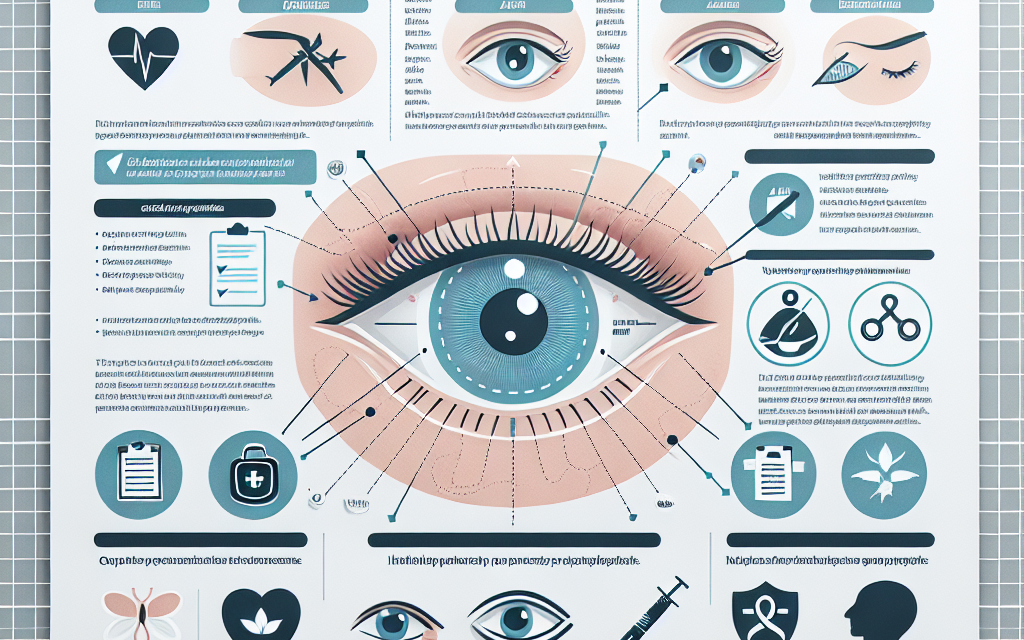Is Blepharoplasty Safe? A Guide to Risks and Prevention of Complications
Blepharoplasty, commonly known as eyelid surgery, is a cosmetic procedure aimed at improving the appearance of the eyelids. It can involve the removal of excess skin, fat, and muscle from the upper and/or lower eyelids. While many individuals seek this surgery to enhance their aesthetic appeal or to address functional issues such as impaired vision, it is essential to understand the safety of the procedure, the potential risks involved, and how to prevent complications. This comprehensive guide will explore these aspects in detail.
Understanding Blepharoplasty
Before delving into the safety and risks associated with blepharoplasty, it is crucial to understand what the procedure entails. Blepharoplasty can be performed on the upper eyelids, lower eyelids, or both. The surgery is typically performed under local anesthesia with sedation or general anesthesia, depending on the complexity of the case and the patient’s preference.
During the procedure, the surgeon makes incisions along the natural lines of the eyelids to minimize visible scarring. Excess skin, fat, and muscle are then removed or repositioned to create a more youthful and alert appearance. The incisions are closed with sutures, which may dissolve on their own or require removal after a few days.
Types of Blepharoplasty
There are two primary types of blepharoplasty:
- Upper Blepharoplasty: This procedure focuses on the upper eyelids, addressing issues such as drooping skin that can obstruct vision and the appearance of puffiness or bags.
- Lower Blepharoplasty: This surgery targets the lower eyelids, primarily to remove or reposition fat deposits that create a tired or aged appearance.
Both types of blepharoplasty can be performed independently or in conjunction with other cosmetic procedures, such as facelifts or brow lifts, to achieve a more comprehensive rejuvenation of the facial area.
Assessing the Safety of Blepharoplasty
When considering any surgical procedure, safety is a paramount concern. Blepharoplasty is generally regarded as a safe procedure when performed by a qualified and experienced surgeon. However, like any surgery, it carries inherent risks. Understanding these risks can help patients make informed decisions and prepare adequately for the procedure.
Common Risks Associated with Blepharoplasty
Some of the common risks associated with blepharoplasty include:
- Infection: As with any surgical procedure, there is a risk of infection at the incision sites. Proper post-operative care and hygiene can help mitigate this risk.
- Scarring: While surgeons aim to place incisions in natural creases to minimize visible scarring, some patients may experience noticeable scars.
- Dry Eyes: Patients may experience dryness or irritation in the eyes following surgery, which can be temporary or, in rare cases, long-lasting.
- Vision Changes: Although rare, some patients may experience temporary or permanent changes in vision, including double vision or blurred vision.
- Asymmetry: There is a possibility of asymmetry in eyelid appearance post-surgery, which may require additional corrective procedures.
It is essential for patients to discuss these risks with their surgeon during the consultation process. A thorough understanding of potential complications can help patients weigh the benefits against the risks.
Factors Influencing Safety and Complications
Several factors can influence the safety of blepharoplasty and the likelihood of complications. Understanding these factors can help patients take proactive steps to minimize risks.
Patient Health and Medical History
A patient’s overall health and medical history play a significant role in determining the safety of blepharoplasty. Factors to consider include:
- Chronic Conditions: Conditions such as diabetes, hypertension, and autoimmune disorders can increase the risk of complications during and after surgery.
- Medications: Certain medications, particularly blood thinners, can increase the risk of bleeding and should be discussed with the surgeon prior to surgery.
- Smoking: Smoking can impair healing and increase the risk of complications. Patients are often advised to quit smoking several weeks before and after surgery.
Surgeons typically conduct a thorough pre-operative assessment to evaluate these factors and determine the patient’s suitability for the procedure.
Surgeon Experience and Credentials
The experience and credentials of the surgeon performing the blepharoplasty are critical to the safety of the procedure. Patients should consider the following:
- Board Certification: Ensure that the surgeon is board-certified in plastic surgery or ophthalmology, as this indicates a level of training and expertise.
- Experience with Blepharoplasty: Inquire about the surgeon’s experience specifically with blepharoplasty and their track record of successful outcomes.
- Before-and-After Photos: Reviewing before-and-after photos of previous patients can provide insight into the surgeon’s skill and aesthetic sensibility.
Choosing a qualified and experienced surgeon can significantly reduce the risk of complications and improve overall satisfaction with the results.
Preventing Complications: Pre- and Post-Operative Care
Preventing complications during and after blepharoplasty involves careful planning and adherence to pre- and post-operative care guidelines. Patients can take several steps to ensure a smooth recovery and minimize risks.
Pre-Operative Preparation
Proper preparation before surgery is essential for reducing the risk of complications. Key steps include:
- Consultation: Attend a thorough consultation with the surgeon to discuss goals, expectations, and any concerns. This is also the time to disclose medical history and medications.
- Pre-Operative Testing: Depending on individual health factors, the surgeon may recommend blood tests or other evaluations to assess readiness for surgery.
- Medication Management: Follow the surgeon’s instructions regarding medications, including discontinuing blood thinners and avoiding certain supplements that can increase bleeding risk.
- Arranging Support: Plan for someone to accompany you to the surgery and assist with post-operative care, as you may experience temporary limitations in mobility.
Post-Operative Care
Following surgery, adhering to post-operative care instructions is crucial for a successful recovery. Important post-operative care tips include:
- Follow-Up Appointments: Attend all scheduled follow-up appointments to monitor healing and address any concerns promptly.
- Ice Packs: Use ice packs on the eyes to reduce swelling and discomfort during the initial recovery period.
- Medications: Take prescribed medications as directed, including pain relievers and antibiotics, to prevent infection and manage discomfort.
- Avoid Strenuous Activities: Refrain from heavy lifting, vigorous exercise, and activities that may strain the eyes for several weeks post-surgery.
By following these guidelines, patients can significantly reduce the risk of complications and promote optimal healing.
Case Studies and Real-Life Experiences
Understanding the experiences of others who have undergone blepharoplasty can provide valuable insights into the procedure’s safety and potential complications. Here are a few case studies that highlight different outcomes and considerations.
Case Study 1: Successful Upper Blepharoplasty
A 55-year-old woman underwent upper blepharoplasty to address drooping eyelids that were affecting her vision. After a thorough consultation and pre-operative assessment, she was deemed a suitable candidate for the procedure. The surgery was performed under local anesthesia, and she experienced minimal discomfort during recovery.
Post-operative care included ice packs and prescribed medications. She attended all follow-up appointments, and her healing progressed without complications. At her six-week follow-up, she reported significant improvement in her vision and was pleased with her refreshed appearance.
Case Study 2: Complications from Lower Blepharoplasty
A 60-year-old man opted for lower blepharoplasty to remove bags under his eyes. Unfortunately, he experienced complications due to pre-existing health conditions that were not disclosed during the consultation. He developed an infection at the incision site, which required additional treatment and delayed his recovery.
This case underscores the importance of full disclosure during the consultation process and highlights how underlying health issues can impact surgical outcomes. After treatment, the patient eventually healed but required additional follow-up care to address the complications.
Case Study 3: Asymmetry Post-Surgery
A 45-year-old woman underwent both upper and lower blepharoplasty. While the surgery was successful, she noticed slight asymmetry in her eyelids during the healing process. After discussing her concerns with her surgeon, they agreed to a minor revision procedure to correct the issue.
This case illustrates that while complications can arise, open communication with the surgeon can lead to satisfactory resolutions. The patient was pleased with the final results after the revision.
Conclusion: Key Takeaways on Blepharoplasty Safety
Blepharoplasty can be a safe and effective procedure for enhancing the appearance of the eyelids and improving vision. However, it is essential for potential patients to understand the risks involved and take proactive steps to minimize complications. Key takeaways include:
- Understanding the types of blepharoplasty and what the procedure entails is crucial for informed decision-making.
- Assessing personal health factors and choosing a qualified surgeon are vital steps in ensuring safety.
- Pre-operative preparation and diligent post-operative care can significantly reduce the risk of complications.
- Learning from real-life experiences can provide valuable insights into the potential outcomes of the procedure.
Ultimately, with careful planning and consideration, blepharoplasty can lead to satisfying results, enhancing both appearance and quality of life. As with any surgical procedure, thorough research and open communication with healthcare providers are essential for achieving the best possible outcomes.





